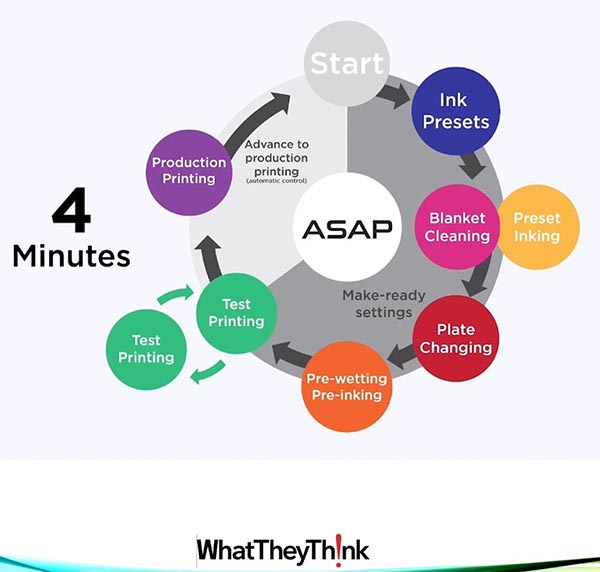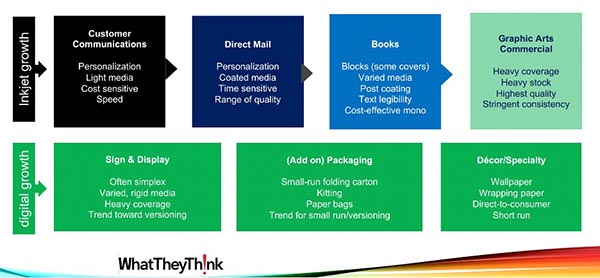Every year, WhatTheyThink takes a look the state of production print, and this year was no exception. The WhatTheyThink webinar “Technology Outlook: Production Print,” part of our Technology Outlook Week LunchNLearn Webinar Series, looked at key trends, technologies, and products on the production side of the business.
The webinar, which covered offset, toner, and inkjet, was presented by Elizabeth Gooding of Insight Forums and Patrick Henry, contributing editor of WhatTheyThink.
Before getting to trends, technologies, and products, however, Gooding took out her sword and to slay some mythical dragons of production print. “If you talk to printers about their favorite processes, you will hear lot of truisms and beliefs about print quality and other issues that people believe but aren’t true,” Gooding says. “Let’s get past two of those now.”
- Inkjet is the only process with print artifacts.
Have you heard this one? It’s commonly believed, but Gooding says, it’s just not true. “Every process has its issues,” she explains. “So let's pick on all the processes for a minute.”
- Offset, she points out, can have picking, ghosting, and offsetting from the roller onto your material. Different coverages can create graininess, registration problems, or banding.
- “Of course, inkjet can have all of those problems too, albeit they result from a different cause,” she says.
- Toner, too, has its own issues, including (like offset) the ability to maintain color from run to run. “Sometimes, even within the run unless you put in a lot of work,” she says.
- Makeready times are an offset issue.
Think only offset has makeready issues? This is not necessarily true either. This is because makeready includes more than the time to get the press up to color. It includes wastepaper generated during the process and throughout the entire run. When you look at it as an end-to-end issue (in other words, taking into consideration downtime), it is a challenge faced by all processes.
To look at how offset is addressing the issue, Gooding passed the torch to Patrick Henry. “Today, it’s not uncommon to hear of offset makereadies being completed in 100 sheets, perhaps 125 or 150,” Henry explained. “That doesn't happen universally, but it's not unusual to hear. Depending on how automated the plate changing system on the press is, we can now get from job A to job B in 8-10 minutes.”
These gains, he says, are being made by pushing an increasing amount of data to printing systems. “The more data you can get to that press, the more things you can preset, and the more compressed your makeready is.”
Automated Smart Assisted Production to the Rescue
Henry then focused on a slide on automated smart assisted production. The example given was from RMGT showing the sequence of events that can now be automated with a one touch of a button. These include:
- Ink/paper presets
- Blanket cleaning
- Plate changing
- Test printing
- Registration adjustment
- Ink density adjustment
The result is makeready in as little as four minutes, depending on the complexity of the job. “I think we can agree that offset makereadies are now running on a much different clock than they used to,” Henry says. “This is a result, not just of improvements in press automation, but links to pre-press, post press, and the entire IT infrastructure of the enterprise as a whole.”

The goal, Henry explained, is to synchronize the resources and exchange data in a way that enables the entire operation to achieve peak productivity and profits. “While we are focusing a lot of attention here on machines and data, the most significant contribution of these advances may be on the human side,” he continues. “For years now, the industry has had a chronic problem attracting and retaining people on the production side. The pool of talent gets smaller every year. Improvements in automated makeready and automated production give printers an alternative to scouring the labor market for candidates that the labor market is increasingly unable to provide.”
Hence, Henry says, why sheetfed press manufacturers now bundle workflow and press control software with their equipment.
Henry then outlined offerings by a variety of manufacturers and OEMs, with links to additional information in the downloadable slides.
And Now We Turn to Inkjet…
Next, Henry handed the discussion back to Gooding, who looked at makeready on the inkjet side. She noted that, while inkjet makeready is different from offset—"because you don't necessarily have to makeready every single job”— you still have to do it, she says.
Gooding discussed two key areas that impact end-to-end makeready: media handling and maintenance. “Sure, time to ‘up to color’ is important, but so is the process of making sure that the print quality is consistent so that you don't have to shut down the press to address it,” she explains. “Downtime matters! That’s why the faster a continuous press goes, the more important automating [and monitoring] that paper changing and winding and splicing becomes.”
Included and linked from the presentation slide, Gooding explains, is a downtime cost calculator so printers can calculate just how costly that downtime can be.
Gooding notes that while material handling capabilities like the winding and splicing keep inkjet presses running continuously with less labor, without monitoring and maintenance capabilities, printers will not get the full benefit out of them. “With a really fast press, you can run a lot of bad print through before you catch an error,” she says. “So things like inline print quality monitoring and automated print head maintenance (and on sheetfed presses, ways to deflect damaged sheets or sheets that can get stuck together) are ways to keep the press up and running.”
Examples include:
- Data/AI-based planning
- Color management
- Inline quality control
- Nozzle out detection
- Nozzle redundance
- Automatic head cleaning
“To give one example,” Gooding continues, “Canon estimates that its newest B3 varioPRINT with its combination of high paper capacity, media handling controls, and print quality management will allow the press to run unattended for up to three hours. As Patrick discussed, this is a big deal in terms the labor management as well.”
How Are Volume Shifting?
Thanks to the efficiencies in workflow that have arisen on the offset and the inkjet sides, Gooding notes that growth in inkjet volume will continue to be driven by its ability to process multiple jobs efficiently rather than just competing on the individual long run jobs where offset is strong.

Software plays a critical role here,” she explains. “We need software that can logically concatenate jobs based on paper type, finishing requirements, and other factors critical to productivity. Today, almost every OEM has software options, and there are third-party tools as well. Technology availability really isn't the problem at this point.”
Henry adds that while certain types of work have migrated from conventional to digital, one of the burning questions is what types of work are most likely to continue to migrate from conventional to inkjet and why. But after showing a slide with some of the key trends, Gooding pointed out that the “on the ground” situation is more complicated than that.
“It’s interesting,” she says. “I've talked to a number of customers who have both offset toner and inkjet, and some of them say that they wouldn't be able to keep their offset presses full without having inkjet, as well, because with inkjet they are able to take on a mix of work for a specific customer or because they're able to handle both the long run and short run variations of what that customer needs cost effectively. Inkjet can’t do it alone, but it allows them to win an overall book of business.”
Gooding then walked through many of the trends driving adoption of continuous and sheetfed digital production. But it’s challenging, she says, because not every press is going to be the right fit for everything. The “right” press is going to be application dependent.
Want to Nerd Out? Click Here!
The webinar rounded out with discussion of how each of the press types competes against the other with technological advances, introductions of various press sizes and capabilities. To nerd-out on feeds and speeds and “under the hood” discussions, both current and not-yet-released on a wide variety of presses, you can view the entire webinar here.















Discussion
Only verified members can comment.